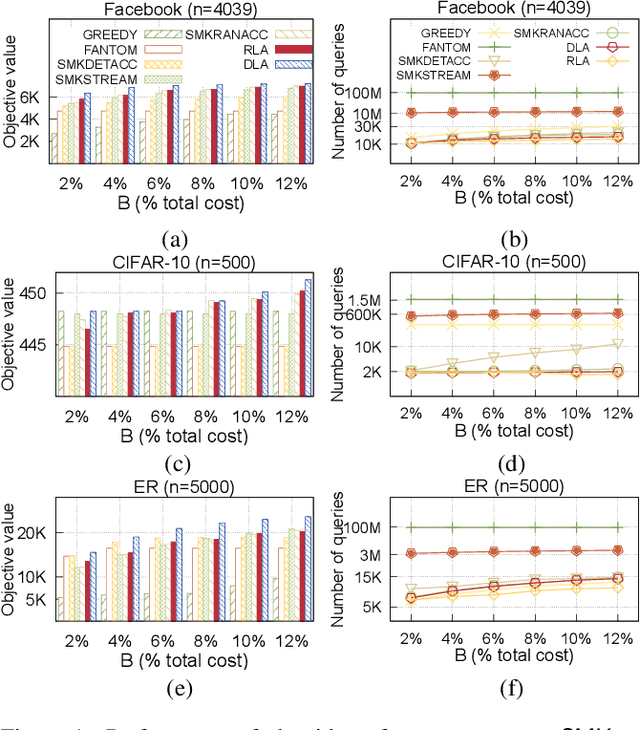Dung T. K. Ha
Improved Parallel Algorithm for Non-Monotone Submodular Maximization under Knapsack Constraint
Sep 06, 2024

Abstract:This work proposes an efficient parallel algorithm for non-monotone submodular maximization under a knapsack constraint problem over the ground set of size $n$. Our algorithm improves the best approximation factor of the existing parallel one from $8+\epsilon$ to $7+\epsilon$ with $O(\log n)$ adaptive complexity. The key idea of our approach is to create a new alternate threshold algorithmic framework. This strategy alternately constructs two disjoint candidate solutions within a constant number of sequence rounds. Then, the algorithm boosts solution quality without sacrificing the adaptive complexity. Extensive experimental studies on three applications, Revenue Maximization, Image Summarization, and Maximum Weighted Cut, show that our algorithm not only significantly increases solution quality but also requires comparative adaptivity to state-of-the-art algorithms.
Robust Approximation Algorithms for Non-monotone $k$-Submodular Maximization under a Knapsack Constraint
Sep 21, 2023Abstract:The problem of non-monotone $k$-submodular maximization under a knapsack constraint ($\kSMK$) over the ground set size $n$ has been raised in many applications in machine learning, such as data summarization, information propagation, etc. However, existing algorithms for the problem are facing questioning of how to overcome the non-monotone case and how to fast return a good solution in case of the big size of data. This paper introduces two deterministic approximation algorithms for the problem that competitively improve the query complexity of existing algorithms. Our first algorithm, $\LAA$, returns an approximation ratio of $1/19$ within $O(nk)$ query complexity. The second one, $\RLA$, improves the approximation ratio to $1/5-\epsilon$ in $O(nk)$ queries, where $\epsilon$ is an input parameter. Our algorithms are the first ones that provide constant approximation ratios within only $O(nk)$ query complexity for the non-monotone objective. They, therefore, need fewer the number of queries than state-of-the-the-art ones by a factor of $\Omega(\log n)$. Besides the theoretical analysis, we have evaluated our proposed ones with several experiments in some instances: Influence Maximization and Sensor Placement for the problem. The results confirm that our algorithms ensure theoretical quality as the cutting-edge techniques and significantly reduce the number of queries.
Linear Query Approximation Algorithms for Non-monotone Submodular Maximization under Knapsack Constraint
May 17, 2023

Abstract:This work, for the first time, introduces two constant factor approximation algorithms with linear query complexity for non-monotone submodular maximization over a ground set of size $n$ subject to a knapsack constraint, $\mathsf{DLA}$ and $\mathsf{RLA}$. $\mathsf{DLA}$ is a deterministic algorithm that provides an approximation factor of $6+\epsilon$ while $\mathsf{RLA}$ is a randomized algorithm with an approximation factor of $4+\epsilon$. Both run in $O(n \log(1/\epsilon)/\epsilon)$ query complexity. The key idea to obtain a constant approximation ratio with linear query lies in: (1) dividing the ground set into two appropriate subsets to find the near-optimal solution over these subsets with linear queries, and (2) combining a threshold greedy with properties of two disjoint sets or a random selection process to improve solution quality. In addition to the theoretical analysis, we have evaluated our proposed solutions with three applications: Revenue Maximization, Image Summarization, and Maximum Weighted Cut, showing that our algorithms not only return comparative results to state-of-the-art algorithms but also require significantly fewer queries.
 Add to Chrome
Add to Chrome Add to Firefox
Add to Firefox Add to Edge
Add to Edge